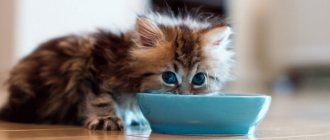The color of a cat's tongue can reveal a lot about your pet's health problems. If the owner notices that the cat’s tongue has turned blue, you should contact a veterinary clinic and undergo an examination of the cardiovascular system, as well as pulmonary work. It should be understood that blueness of the lips, tongue, gums and oral mucosa indicates a lack of oxygen. Dangerous and serious diseases include pneumothorax, pulmonary edema, and heart disease. All these diseases can cause death, so it is very important to start health restoration therapy in a timely manner.
What causes the problem?
Pulmonary edema
A cat with a white tongue and black dots on it may indicate problems with the respiratory system. Of particular danger to a pet is pulmonary edema, in which there is a high risk of death without timely provision of veterinary care. Before prescribing treatment, the pet undergoes diagnostic procedures and determines the degree of the disorder. Therapy in most cases is performed in a hospital setting, where specialists can monitor the cat’s health.
How does pneumothorax occur?
Veterinarians note that a similar pathology, which causes a cat to have a blue tongue, occurs after a fall from a height or bites from other animals.
This pathology is manifested by shortness of breath in the animal, which can quickly turn into suffocation.
The disease is characterized by the accumulation of air in the sternum, while pneumothorax often occurs together with hydrothorax, with fluid filling in the chest cavity. If there is a deviation, the cat’s internal organ is not able to fill with air normally. Sometimes an animal experiences complete failure of one lung. When the cat gets sick, the tongue becomes very blue and the risk of the pet dying from suffocation increases, which occurs due to the continuous flow of liquid and air into the respiratory tract.
Heart defects
When blue spots appear on your cat's tongue or the palate and inside of the mouth turn pale, it is worth taking the animal to the veterinarian. Such symptoms are a signal of the progression of congenital heart defects. With such disorders, the clinical picture is observed in a kitten up to 2 months of age. Among the most common deviations are the following:
- atrial septal defect;
- combined heart defect “tetralogy of Fallot”;
- impaired function of the interventricular septum.
What is asthma associated with?
The symptom often accompanies animals suffering from such a disease of the respiratory system.
A blue tongue in kittens and adult felines can be a consequence of an asthmatic attack. The disease occurs in pets of all ages and occurs with coughing and difficulty breathing. When asthma is advanced, the pet develops cyanosis and respiratory failure. Cat owners can recognize the disease not only by its blue tongue. When taking x-rays, pathological changes in the lungs are observed, and eosinophils are detected in excessive quantities in the blood. The deviation is immune in nature, so it is difficult to completely eliminate it, and sometimes even impossible.
Diaphragmatic hernia: causes of appearance
A cat's tongue is black or has a bluish tint due to a fall from a great height, which leads to rupture of the diaphragm and prolapse of internal organs into the chest. In this case, air enters the respiratory tract incorrectly, causing oxygen deficiency and blue mucous membranes of the tongue. The pathology can only be eliminated surgically, in which the displaced internal organs are returned to their original place, and the diaphragm is sutured. It is important to understand that such assistance is provided only with the early diagnosis of a diaphragmatic hernia.
Causes of blue tongue in cats
The language takes on unnatural shades due to a number of diseases. One of the causes of cyanosis may be congenital heart disease. The color of a cat's tongue changes after a fall from a great height, chest injuries, dog bites, or inflammation. Other reasons :
In both cases, the cat feels a lack of air. The lungs may stop functioning on the right or left side - partially or completely. If the processes of pneumo- and hydrothorax do not stop, the tongue takes on an increasingly blue tint, and the animal dies from an attack of suffocation.
Cyanosis (blue tongue in a cat) can develop in minutes or over several days. At the same time, the shade becomes more and more saturated. In this case, frequent breathing is observed (the animal’s mouth is open at this time) and shortness of breath. Cyanosis can also be caused by :
Often the cause of dark blue, almost black spots can be normal pigmentation. However, it can be congenital. The spots increase in size with age. More often, fluffy and red cats are susceptible to this defect. Over time, bluish spots may acquire a brownish tint.
When the mucous membranes and tongue turn blue, this often indicates heart disease. Brown or gray plaque on the gums indicates pathologies of the stomach, lungs and intestines. In case of gastrointestinal disorders, food can be thrown back with vomiting, staining the mucous membranes.
The alarm should only be raised when there are additional negative signs - refusal to eat, lethargy, apathy, etc. However, you cannot do anything with the animal yourself; in any condition it must be shown to a veterinarian.
Well, that’s all, mistress, it’s time for us to say goodbye. The Rainbow is calling me on the road, And don’t be sad here, I’ll be in your dreams, I’ll purr once, and your pain will go away. Don't cry, mistress. No, I beg you. After all, all the same, there is no turning back, And it’s not sweet for me anyway, I’m leaving You, my family and the warm light of the sun. But if you want to make my path easier, And illuminate the distance with warmth and light, Kiss a homeless kitten harder Give me the opportunity to love you in him You give him everything that you have always given me, Love and affection, tenderness and comfort, And I I rest in peace with the rainbow And I know that everyone loves me here. I’m not offended at you at all, just trust your pet. The time has come... I say goodbye to everyone... Hostess, Close the door behind me... (My cat Mashenka also died once... As I understand you...
Source
Additional symptoms
A situation often occurs when, with such a manifestation, the animal still does not eat.
A cat's tongue has a black tongue or a blue coating on it, as a rule, occurs against the background of serious diseases of various organs and systems. In case of deviations, the following signs are observed:
- severe shortness of breath not associated with physical activity;
- protruding tongue;
- restless state;
- lethargy;
- lack of appetite.
Types of vomiting
Vomiting in any form is a serious reason to consult a veterinarian, please do not delay. The causes of the gag reflex can be judged by the type and shade of the vomit. Let's consider various options. First of all, you need to decide on the appearance, composition and color of the vomit.
Vomiting white foam
This phenomenon is common in young kittens that have recently been introduced to solid food. The cause of the gag reflex is an overfilled stomach. The vomiting attack is strong and prolonged. White foam is a mixture of gastric juice with secretions from the mucous membrane. Similar vomiting also occurs in adult animals when changing food. For example, if you give your pet canned food instead of dry food, he will eat it with pleasure.
The cause of vomiting in this case is banal overeating.
The appearance of foamy vomiting is a symptom of the initial stage of gastritis. If the foam has taken on a yellowish tint, this indicates infection with worms. Intoxication of the body increases, and the liver is involved in the process. Hence the coloring of vomit the color of bile.
If a cat is vomiting white foam, this may be a symptom of poisoning, such as detergents. In this case, consultation with a specialist is required.
Vomiting clear mucus
The mucous in cat vomit is gastric juice. This phenomenon is typical for helminthic infestations, chronic gastritis or gastric erosion. Vomiting with mucus also occurs in infectious diseases. It is important to monitor for the presence of impurities and additional inclusions, such as helminth fragments.
Vomiting of gray matter
This is the appearance of partially digested food. There are various reasons: overeating, the initial stage of pregnancy in cats, or regurgitation of hair swallowed during licking. The last case is a variant of the norm. The gag reflex is a protective reaction of the body, a quick removal of everything foreign.
Vomiting green liquid
Causes of green vomit in cats:
- Food poisoning. The reason for the greenish tint is bile impurity. This is the liver's reaction to intoxication.
- Infection.
- Problems with the gastrointestinal tract (reflux of intestinal contents into the stomach). This is a serious symptom, and you cannot delay visiting the veterinarian, otherwise the animal will die.
- Diseases of the liver and gall bladder, including cancer.
What to do and how to fix the problem?
If blue dots appear on your tongue or it turns white, you should immediately contact a veterinary clinic. A specialist will help determine the severity of the pathology and select therapeutic measures. Treatment is selected after a comprehensive examination. Thanks to this method, it is possible to assess the condition of the internal organs and find out the true reason for the blue tongue of the cat. The following diagnostic procedures are prescribed for the pet:
- laboratory testing of urine and blood;
- chest x-ray;
- ultrasound examination;
- analysis of the fluid contained in the sternum.
Air and fluid are usually removed from the animal's lungs during a simple operation.
Therapy is selected based on the diagnostic results and depends on the type of disorder that caused the cat to develop black spots on the tongue. If pneumothorax is detected, the specialist pumps out fluid or accumulated air from the sternum. The manipulation is performed after the pet has taken a small amount of the drug with a sedative effect. General anesthesia may often be required. A diaphragmatic hernia, which causes a cat to have a blue tongue, can only be dealt with through surgery. Surgery is prescribed when a hernial protrusion is detected in the early stages.
If a hernia in the diaphragm does not affect the general condition of the animal, then surgical intervention may not be performed.
The greatest danger to the health and life of a pet is pulmonary edema. To prevent the cat from dying, it is necessary to contact a veterinary clinic in a timely manner, where the animal will receive assistance. Treatment for pathology is carried out in a hospital setting, especially if symptoms of respiratory failure are recorded. After stabilization of the condition and elimination of the blue tongue and other signs of pathology, periodic prophylaxis is required to prevent recurrence of pulmonary edema.
Diseases of cats and cats: symptoms and treatment
According to many people, cats are one of the most tenacious creatures. Is this really how it is?
Indeed, it is difficult to classify cats as sick creatures. They are less susceptible to various diseases than other animals. But like any animal, cats can get sick with specific feline diseases or catch a cold, and they can become obese.
It is worth mentioning that domestic (pedigreed) cats are more susceptible to diseases than barn cats. Long-haired cats get sick more often than short-haired cats.
Determining the symptoms of the disease in cats is quite problematic.
When cats become ill, they behave like steadfast tin soldiers, often hiding their illness.
Cats can have similar symptoms for different diseases. Therefore, to establish the cause of the disease and correct diagnosis, the cat should be immediately shown to a veterinarian. By the appearance and habits of the animal, you can determine the true state of health of your pet.
If a cat is active, eats well, and has a shiny, well-groomed coat, then it is completely healthy.
If the owner sees that the cat is lethargic, sleeps a lot, eats poorly and has unkempt fur, then this is a clear sign that not everything is in order with your pet’s health.
In this case, you should not hesitate to contact a veterinarian; delay may negatively affect the animal’s well-being.
Commonly known symptoms
One of the clearest criteria for a cat’s health is its fur. If the cat's fur is smooth and shiny, there is no dandruff, and the cat does not itch constantly, then this is evidence of health. Your nose will tell you about your temperature.
The normal temperature of an adult cat is 38-39 degrees, for a kitten it is above 39.5 degrees.
A moist and cool nose indicates that the temperature is normal. A dry nose indicates an elevated temperature. In this case, the cat often licks its lips.
A low temperature is more dangerous than an elevated temperature and indicates that the cat’s immune system is weakened and the body is poorly resistant to the disease.
If a cat's eyes become large and the pupils are not visible, then this is a clear symptom that the cat is in pain and is clearly unwell. A cat's breathing at rest is always smooth and inaudible. If your cat's mouth is open and breathing is rapid and noisy, it means your cat has health problems. It could be a heart attack or stroke, or it could be heatstroke.
Visible symptoms of the painful condition include various types of discharge from the eyes, nose, as well as a pale, blue tongue. Obvious symptoms of cat diseases include vomiting, constipation and diarrhea. This is a clear signal of the possible development of a serious internal pathology in the animal, requiring immediate examination.
- Symptoms of cat diseases
- Symptoms of cat diseases
- Symptoms of cat diseases
Vaccination prevents infection from certain infectious diseases. A cat may develop diseases that other mammals suffer from: diabetes, cancer, asthma, kidney disease.
The most common diseases in cats:
Asthma Chronic renal failure Cancer Diabetes Leukemia Urolithiasis Liver amyloidosis Hyperthyroidism Immunodeficiency virus Hepatic lipidosis Infectious peritonitis Hypertrophic cardiomyopathy Ringworm
Liver diseases
Before you take your cat home, you should make sure it is healthy. Every year your cat needs a veterinary examination. The earlier you detect a disease, the easier it is to treat.
There are diseases that can be transmitted from cats to humans, but this does not happen often. These diseases are: Cat scratch fever Rabies Ringworm
Toxoplasmosis
If your cat has the following symptoms, this means that the pet is sick: the cat lies with its paws tucked in for a long time; lethargy (accompanies almost all illnesses in cats); the cat's body is hot (probably fever); poor appetite or refusal to eat; loss of body weight, even if the cat has normal appetite the animal drinks much more than usual urinating very frequently or in large quantities straining to urinate (take the animal to the vet immediately) persistent sneezing hoarseness, choking or difficulty breathing the cat is coughing, gagging diarrhea or blood in the urinary tract convulsions, seizures, trembling, twitching and disorientation in the animal bleeding, except scratches or swelling
the animal sways and limps.
Skin diseases that are easiest to diagnose are the purr. The most common types are wet and dry eczema, tangles, and trichomes.
If your cat is covered in red spots, itches all the time and has hair falling out, it most likely has dry eczema. But wet eczema is characterized by the appearance of weeping red spots, and this disease occurs due to allergies.
Matted hair or tangles, this disease is typical mainly for long-haired cat breeds.
Hypertrophic cardiomyopathy. Disease in cats.
Common infectious diseases in cats are colds, sore throat, and bronchitis. The symptoms of these diseases in cats are very similar to those in humans. The disease is accompanied by a runny nose, cough, indigestion and fever. For example, bronchitis usually affects weakened and old animals.
Bronchitis is an inflammation of the lining of the bronchi in cats, and can be acute or chronic. For effective treatment, first of all, you need to provide the animal with good nutrition and a warm place, because feline bronchitis occurs with the same symptoms as in humans (chills, increased body temperature, fever).
For treatment, you need to use expectorants and disinfectants, medications that dilate the bronchi, antibiotics, antimicrobial agents, and inhalations.
- Symptoms of cat diseases
- Symptoms of cat diseases
- Symptoms of cat diseases
Common diseases
The most common diseases in porridges are parasitic. Timely prevention is the best treatment for these diseases. You can find many different anthelmintic drugs in any pet store or veterinary pharmacy.
In the end, you should always remember about skin parasites: fleas, ticks, lice eaters. It is enough to simply treat the cat with insecticidal shampoo, as written in the instructions.
Another option is to rub an antiparasitic agent into the skin, in the area of the withers, of which there are many in veterinary pharmacies.
Another disease that a cat can get is otitis media (inflammation of the middle ear). This disease brings unbearable pain to your pet. The main cause of this disease is drafts, plus microorganisms such as streptococcus and staphylococcus.
Common symptoms of this disease are: loss or significant decrease in appetite, ear pain, fever, apathy, and sometimes vomiting.
For treatment, it is necessary to take a course of antibiotics. And, also, it is necessary to regularly wash the cat’s ears with hydrogen peroxide (3% solution), then you need to drip 2 drops of iodoform ether inside. And of course, be sure to take painkillers.
Cats are very susceptible to a disease such as purulent conjunctivitis; it is most often caused by pyogenic microorganisms. The main symptom of the disease is the appearance of a characteristic purulent sac on the animal’s eye.
When treating this disease, it is imperative to use intramuscular antibiotics.
Also, you need to regularly and methodically wash your cat’s eyes with a weak solution of furatsilin, and be sure to apply ointments such as tetracycline, oletethrin, erythromycin to the conjunctival sac every day. If necessary, give sulfonamide drugs orally.
Infectious diseases of cats and dogs
Source: https://www.kotodom.ru/bolezni-koshek-i-ih-simptomy/
General information: what is the tongue for, the anatomical structure of the organ
Your kitty's tongue is a multi-functional tool. It is used for food and drink, performing the function of a kind of “spoon”; with its help, the animal keeps its fur and skin in order. Thus, with any more or less serious diseases of this organ, the animal will have serious problems.
Any inflammatory pathology of the oral cavity can lead to such consequences. The simplest and most common option is stomatitis, also known as inflammation of the tissues of the oral cavity. Glossitis is not uncommon and quite probable (this term refers to inflammation of the tongue itself). It is possible that a whitish coating on the surface of the organ appeared as a result of gingivitis (that is, the same inflammation, but this time of the gums).
The whitish color of the tongue is a rather characteristic, specific symptom, indicating the initial stages of the formation of tartar. If at this moment you start treating your teeth and tongue with a weak water-salt solution, or a solution of baking soda, serious consequences can be avoided. In addition, a white tongue (more precisely, the root of the tongue) is a fairly common sign of acute gastritis (inflammation of the gastric mucosa). With chronic inflammation, the tongue also turns white, but more often this can be noticed only during the period of exacerbation of the disease.
Sometimes this phenomenon indicates fungal pathologies of the oral cavity. These are very dangerous diseases. If you do not deal with them in any way, the health and even life of your pet will be in serious danger. The most common pathology of this type is oral candidiasis. The smell from the mouth with these ailments becomes extremely unpleasant and even disgusting.
In addition, a fairly typical reason for a sudden change in the color of the tongue is the action of irritating and caustic substances. Possibly household chemicals. Dangerous compounds cause the outer layer of cells covering the tongue to coagulate, causing it to turn white.
The cat's tongue, like the human tongue, consists of many transverse and longitudinal muscles, with the help of which our pets can not only extend and hide their tongue in the mouth, but also move it in different directions and fold the tongue into a ladle. The latter is especially convenient when drinking - water is retained in the recess without splashing out of the mouth.
One of the reasons why a cat sticks out the tip of its tongue is a function of thermoregulation. The wet tongue quickly releases some of the heat accumulated by the cat's body, somewhat easing the pet's condition in extreme heat. If the pet is very hot, the cat breathes heavily with its tongue hanging out. For dogs, this behavior is the norm, but for cats it is a signal that the ambient temperature has reached a critical norm. If you don't help your pet, heat/sunstroke is possible.
Although the reason why a cat sticks out the tip of its tongue may be much more banal - the pet recently ate or washed itself, and simply “forgot” to put its tongue in its mouth. Owners of Persians and exotic cats notice this especially often - the cat sticks out its tongue, as if teasing others. It's all about the shortened bones of the skull: the shape of the muzzle has been changed by selection, as well as the structure of the jaws - the tongue either does not fit in the mouth, or the tip sticks out between the teeth (malocclusion, in which the cat shows the tongue, which normally rests from the inside against the teeth tightly interlocked when the mouth is closed ).
We suggest you read: Loose stools in a cat: what to do, how to treat at home
An inexperienced owner, especially if he has previously had close contact with dogs, is always surprised why a cat has a rough tongue. The touch of a cat's tongue can even be unpleasant - the surface of this organ is so hard and prickly. Residents of Ancient Rus' did not have the opportunity to examine a cat’s tongue in close-up, but the tactile sensations were enough for them to give the cat’s tongue the apt nickname “grater.”
Knowing why a cat has a rough tongue, it is not difficult to imagine what happens to tinsel or thread that gets into the cat’s mouth: the pet cannot spit out the thread (the “spikes” on the tongue that hold a thin foreign object interfere). The cat swallows thread or tinsel - there is simply nothing left for it. Having noticed this, you should not pull the end of the thread: carefully cut off the visible part and give your pet a couple of tablespoons of Vaseline oil.
If you look at a cat’s tongue close up, you will notice that in addition to “spikes”, it is covered with short “sticks”, flat dots and other “growths” - these are also papillae, and they all perform certain functions. In particular, many of them are equipped with taste chemoreceptors, which allow the cat to sense salty, sour and bitter tastes.
Coated tongue
Quite often, black spots on a cat’s tongue go away after eating or drinking water. In this case, we are talking about the usual plaque that appears when eating dark-colored food. Often, a coating on the tongue is discovered after the cat plays with some objects painted in a dark color. Dots on the tongue may remain if the animal has chewed plastic or painted wood. Particles of dye get clogged between the papillae on the tongue and the appearance of dark dots and spots is created.
It is very easy to distinguish plaque from pigmentation or vitamin deficiency; just rub your pet’s tongue with a toothbrush. If the dark spots disappear easily and do not appear again, we are talking about plaque. With pellagra, dark areas may clear up, but re-form after some time. Pigmentation on the tongue cannot be removed with any available means.
Owners should be concerned if a dark coating forms on the pet’s lips and nose, and there is also a pronounced putrid odor from the cat’s mouth. In this case, it is recommended to show the animal to a veterinarian and examine the oral cavity. Possible causes include dental disease, gum inflammation and bacterial stomatitis.
Pigmentation in cats
Black dots that suddenly appear on a cat’s tongue are a consequence of the activity of the cells responsible for skin color. Due to increased pigment production, some areas of the mucous membrane become darker in color. This phenomenon is not dangerous, regardless of whether it is acquired pigmentation or the cat has had spots since birth.
Age spots can form as you age. If a cat is prone to such formations, dark spots appear before the age of three. If the animal does not have a tendency to pigmentation, the tongue and nose can remain clean throughout its life.
Many owners mistake black spots on the tongue for symptoms of a fungal infection. Candidiasis and other dermatological diseases of the mucous membranes and skin in cats are manifested by the formation of light spots and dots, but not dark ones. Pigmentation does not cause discomfort. When dark spots appear, the pet’s behavior does not change, appetite does not suffer, and in general there is no cause for concern.
Interestingly, pigmentation in cats is often hereditary and appears in animals with dark fur and dark paw pads. In light cats, white or red with pink paws, pigmentation is very rare.
Pellagra
A disease caused by a lack of vitamin PP and B6 is called pellagra. In cats, this pathology is quite rare and is associated with a monotonous diet. In most cases, hypovitaminosis occurs in animals that eat low-quality dry food in a low price segment.
You might be interested in: How to rid a cat of growths on his pads?
The composition of such feeds is not balanced and does not always meet the needs of the animal’s body for certain vitamins. Pellagra can also be encountered by street animals that do not have a regular diet and eat whatever they can find. Often cats taken from the street suffer from hypovitaminosis, and the owners cannot immediately understand the reason for the lethargy and drowsiness of their furry pet, as well as dark spots on the tongue.
Pellagra in cats appears as spots on the mucous membranes of the mouth, sometimes spots on the tongue, nose and ears. To make an accurate diagnosis, you should consult a veterinarian, since plaque in the ears and nose may be the result of tick-borne infestation, and spots on the tongue may turn out to be harmless pigmentation.
If the diagnosis is confirmed, treatment is carried out by adjusting the diet. It is recommended to purchase special vitamin supplements for cats, depending on the age of the pet. If the cat eats natural food, the following products should be introduced into the diet:
- liver;
- kidneys;
- sea fish;
- milk;
- carrot.
These products are rich in vitamin PP and quickly eliminate its deficiency. To achieve the best effect, it is necessary to combine a therapeutic diet with taking special vitamin supplements. The recommended dosage of vitamins PP and B6 is up to 5 mg per kilogram of pet weight.











